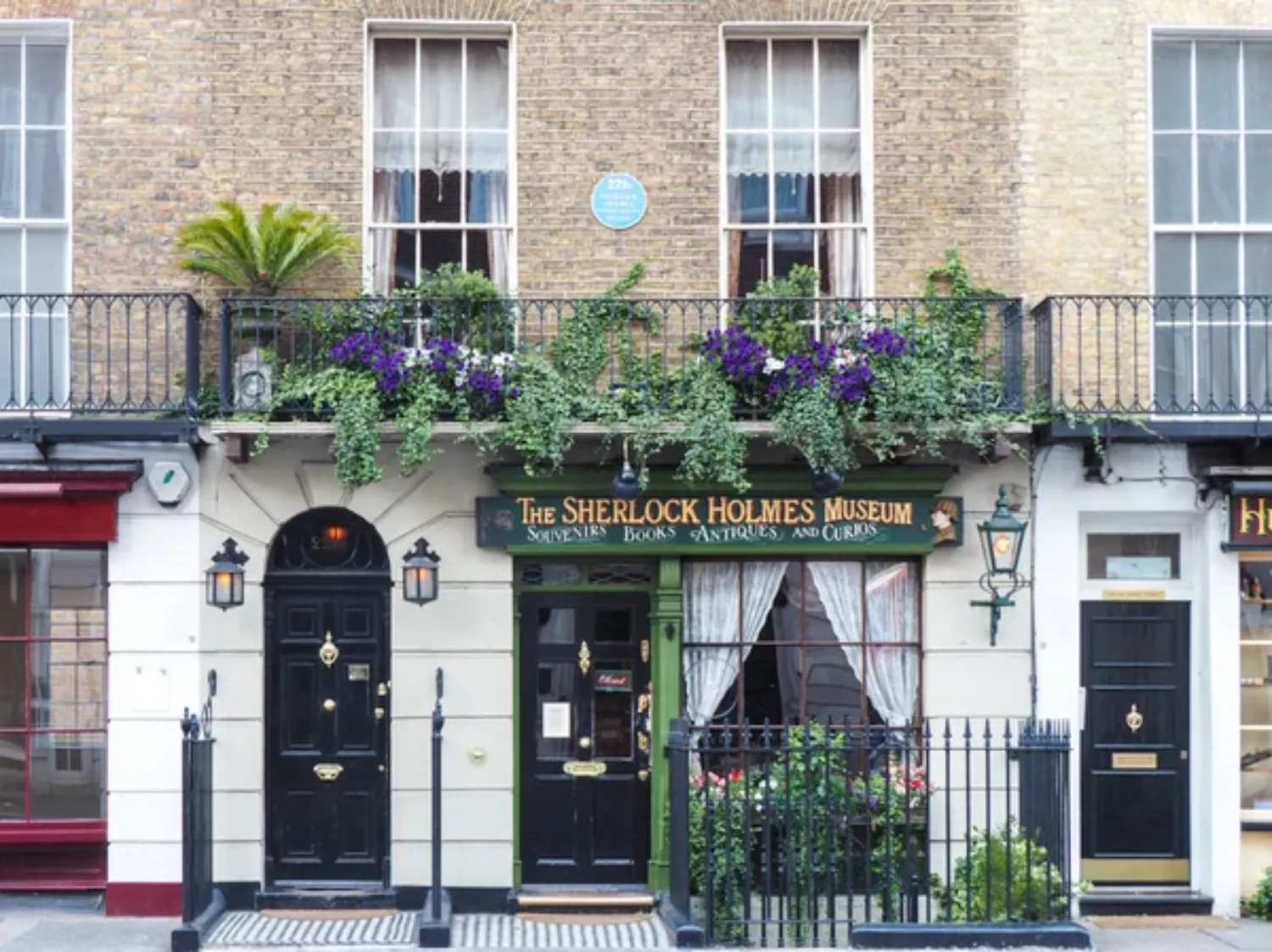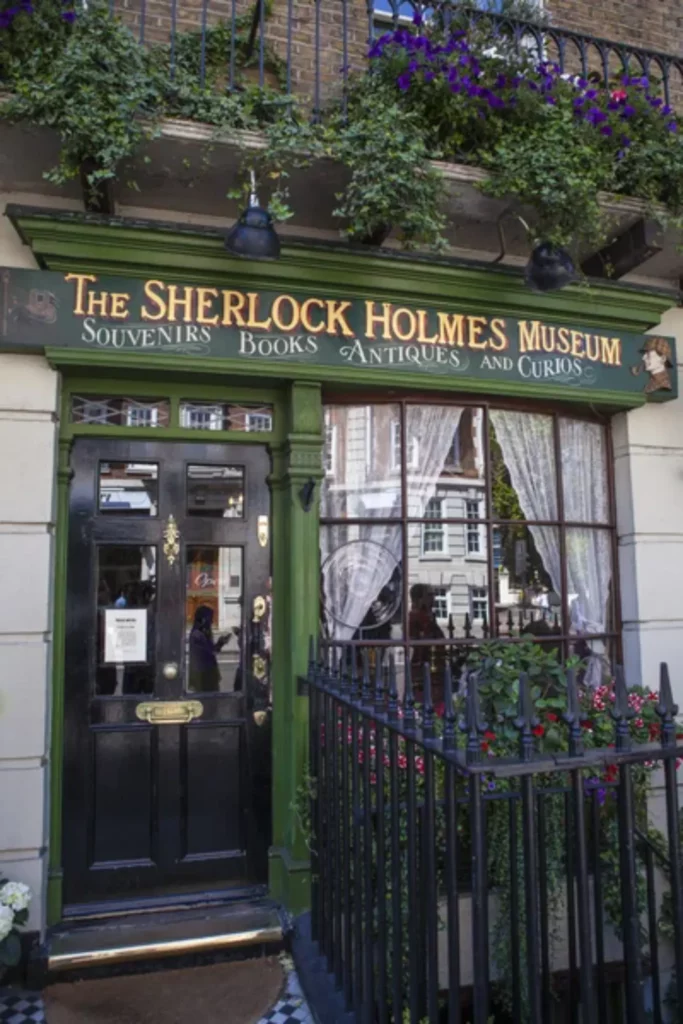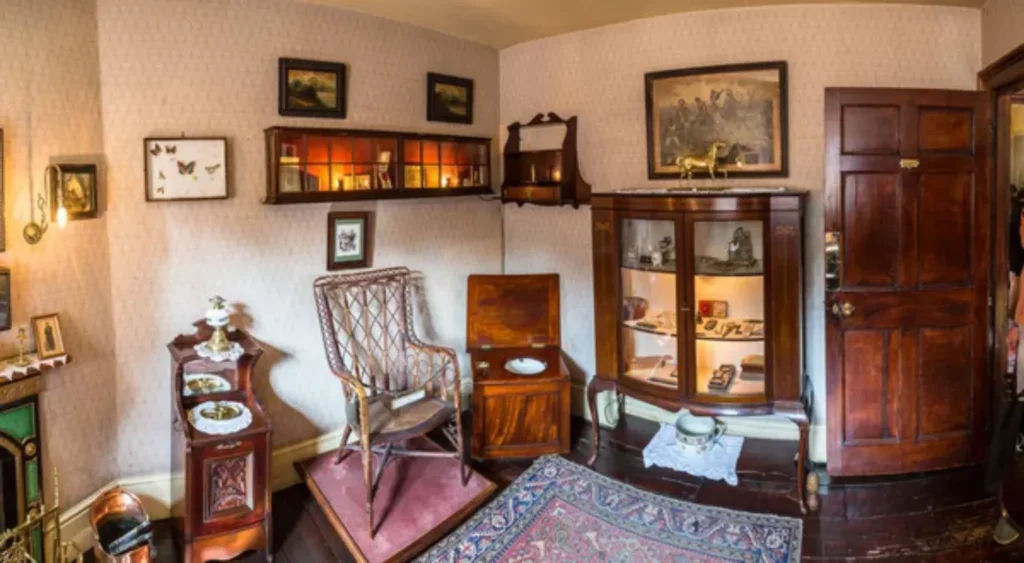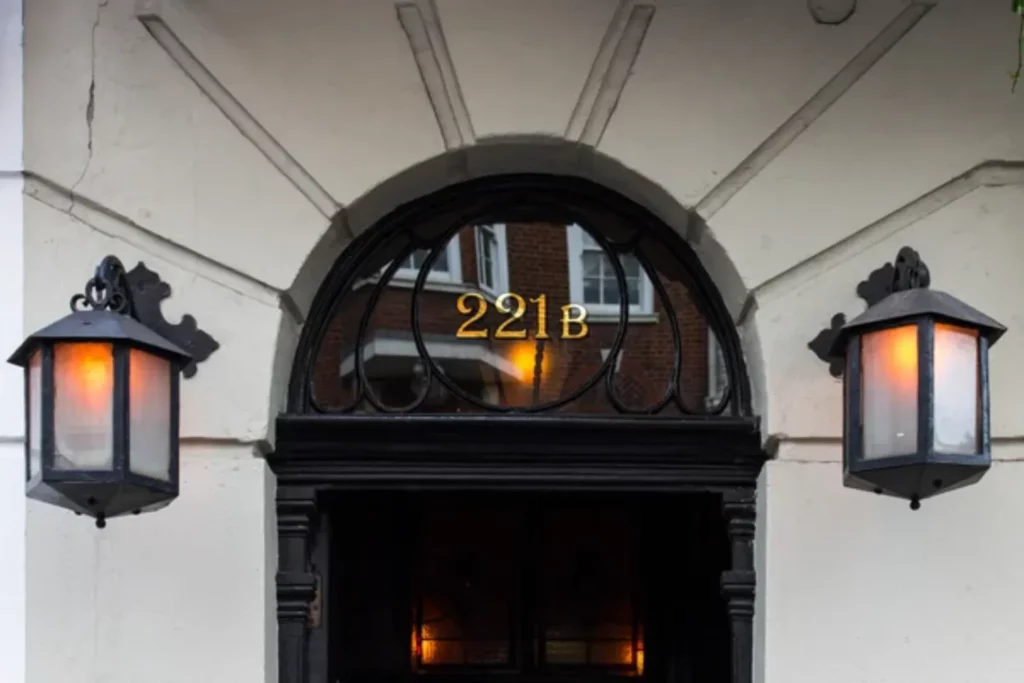The Surreal Story of the Sherlock Holmes Museum

Updated On: April 30, 2024 by Noha Basiouny
Crime novels are incredibly popular among millions of readers around the world. We are obsessed with the suspense they provide, that adrenaline rush, and the heartbeat that rises as the mystery unfolds. We unconsciously engage with the story that we feel so relieved (or utterly frustrated) when we finally know how Mrs McCarthy got the snake venom to kill her friend even though she had never made it outside her tiny neighbourhood.
Ah! This is a legal addiction.
Speaking of that, no one can mention crime fiction without recalling the world’s most meticulous and intelligent yet arrogant detective, Sherlock Holmes. This character appeared for the first time in the late 19th century and has ever since lived. It crossed borders, reached every culture and mesmerised readers, or should we say hypnotised them, that they forgot to pay proper attention to the person who brought this character into existence in the first place, Sir Arthur Conan Doyle.
Arthur Conan Doyle
Sir Arthur Conan Doyle, the famous but not-as-famous-as-Sherlock-himself English writer, was a legend himself. Like Holmes, he excelled in many fields. He was originally an optometrist. Yet, he was much more into writing that chose to focus on it other than medicine; he eventually became one of the most highly prolific writers of the 20th century.
Besides his genius brain that came up with these extraordinary detective stories, Doyle was also talented in many other areas. For instance, he was a goalkeeper, cricket and billiard player, boxer, skiing lover, and very into architecture that he helped design his own house.
However, all of this was overshadowed by Sherlock’s exceptional deduction skills, logical reasoning, and profound observation.
What also contributed to that was the endless adaptations of Sherlock and his loyal friend, Dr Watson. Estimated to surpass 25,000, these adaptations came in all kinds, from stories and comic books to films, TV series and plays.
The more widespread Sherlock became, crossing barriers, touring the world, and impressing millions of audience members from so many different cultures, the more into the shadow Sir Arthur Conan Doyle was pushed.
Even England did not seem to treat Doyle the same way they celebrated Sherlock Holmes. Despite all the recognition they have already given to their talented author, the Britons seemed more concerned about embodying Sherlock and bringing him to life.
How? By establishing a museum for him.
221B Baker Street – The Home of Sherlock Holmes
To better depict everything about Sherlock Holmes and bring it to reality, every little detail that was mentioned in his stories was well taken care of. And it all started with the address 221B Baker Street.
So Sherlock Holmes stayed at 221B Baker Street from 1881 to 1904. Luckily for those who established the museum, Doyle had used a part-actual, part-imaginary address for the house of Sherlock Holmes. In other words, he placed the house in an existent district in London, but the building itself was not there.
So Baker Street is in the Marylebone district. This was, and still is, a chic high-class neighbourhood in London. However, until the time Doyle died, there was no premise with the number 221.
This address came into existence with the first appearance of both Sherlock Holmes and Dr Watson in their very first story, A Study in Scarlet, which was also the first time they met. As both of them were in a harsh financial situation that gave neither of them a chance to have his own room, they had to share a small flat together.
That said, the story of establishing the Sherlock Holmes Museum is pretty surreal, just like Salvador Dali’s painting. Here is what happened.

Surreal?
So, as we mentioned, during the time Sherlock lived at 221B Baker Street, this number was not there in reality. But later on, the street was expanded, and more and more premises were added, including the one numbered 221.
In the first half of that 20th century, the head offices of the Abbey National Building Society, which is basically a bank, settled in venues numbered 219 to 229. Once the readers knew that 221B Baker Street became an actual address, they started sending letters to Sherlock himself as if he were real and living at that address.
All of a sudden, the Abbey National Building Society, which will refer to as just Abbey from here on, was showered with these letters; lots and lots of letters were received every day. But instead of throwing them away or redirecting them to the British Library, they hired a secretary to receive all the incoming mail on behalf of Sherlock and even reply to it!
This is pretty much like what happened in Italy with Shakespeare’s most famous fictional character, Juliet.
Shakespeare was believed to have been inspired by a real, 13th-century casa that was owned by a noble family in Verona, Italy, to create Juliet’s house. Since the story was a great success, the Italians turned that very casa into a memorial and called it Juliet’s House. They even added a balcony to it to accurately follow the description of the house mentioned in the story.
Now, thousands of tourists visit this house every year, totally mesmerised that they even forget Juliet herself was fictional. They even write letters to her, asking for advice about how to handle their relationships, why they cannot forget their ex, and what to do with their broken hearts.
The thing is, a club in the city of Verona called Juliet Club was established to receive these ‘letters to Juliet’ and reply to them with the most proper advice!
OK. Now back to Sherlock.
At this point, one cannot help but wonder why this Abbey Society bothered paying a secretary to reply to all those letters. Such a job has no direct benefit to whoever is doing it nor to the company that hired them. In addition, it is indeed a very demanding job, so why would anyone do it in the first place?
Well, no one knows, and this is precisely what defines surrealism!
Not surreal enough?
Things turned even more bizarre when someone, we do not know who came up with the idea of establishing a museum for Sherlock Holmes. Whoever they were, they were apparently obsessed with Sherlock, that they wanted to bring him to reality.
But they faced a teeny-tiny problem. The premise numbered 221 was already occupied by the Abbey Society. So they had to settle for building number 239. They prepared the building to match the descriptions of Sherlock’s house, and the museum was opened in 1990.
Now that they established a real entity, they started acting upon their new roles of representing and taking care of the legacy of Sherlock Holmes. So the museum management politely asked the Abbey Society to redirect all the mail they received in the name of Sherlock Holmes, which makes sense.
Surprisingly, the bank rejected their request! By that time, they had already spent over 70 years paying secretaries to reply to Selock’s males, which continued ever since the 1930s!
The museum management was outraged. So they reacted unexpectedly and actually went to court with the Abby Society. They were insistent on being in charge of such a very intimate thing about Sherlock’s personal mail. But the court itself could not settle the dispute.
It was only when the Abbey Society had to relocate that this problem was solved. As they moved to another venue, they stopped receiving and therefore replying to Sherlock’s incoming mail. Soon after, the museum took charge of this duty.
The Sherlock Holmes Museum
It seems like Sir Arthur Conan Doyle somehow foresaw the establishment of a museum dedicated to Sherlock Holmes. So he somehow made it so easy for the museum to come into existence because he described everything about it in tremendous detail. This valuable information was the primary reference when the museum was furnished.
So what does this museum look like?

Even though the Abbey Society left the premise numbered 221, the museum was not moved there and was kept in the same building. That building, in itself, is a four-storey townhouse that dates back to 1815. It is characterised by its Georgian architecture. Such style was the mainstream style in England during King George’s era, which extended from the early 18th century to the mid-19th century.
From 1860 to 1936, this townhouse was used as a lodging house where people rented rooms and were provided with meals. Coincidentally this townhouse is very much like Sherlock and Dr Watson’s flat as described by Doyle.
According to the stories, Sherlock and Dr Watson stayed in a small flat on the second floor that was reachable precisely after 17 steps. Although the building might not have the number of steps to the second floor, the museum was well-furnitured to match the description in the stories.
Speaking of furniture, it was Victorian. This makes a lot of sense, as Sherlock lived during the era of Queen Victoria. The first floor, which in the stories belonged to Mrs Hudson, has a fully-furnished sitting room with a fireplace.
After a few steps, one can get to Sherlock’s flat. It comprises several rooms, the most important of which is the study. This used to be Sherlock’s reading and writing room, as well as his very own laboratory where he used to work and do his experiments.
Then there is also Sherlock’s bedroom with a dining table and a typewriter that dates back to the 19th century. That said, Dr Watson’s room is found on the next floor.
In the museum, there is also a gift shop that sells quite a wide range of Sherlock-themed things, such as puzzles, books, notebooks, stationery, T-shirts, socks and ties, as well as prints and many other different souvenirs and antiques.
Interestingly, this building is listed as Grade 2 in England. Buildings listed as so typically have some architectural or historical significance and are preserved for their tremendous value.
The museum is open all week from 9:30 am to 6:00 pm. These opening times, however, may undergo some changes during the holiday season. So it is recommended that visitors check the museum’s website before visiting it. To provide a detailed summary of the experience:
The History of the Sherlock Holmes Museum
The Sherlock Holmes Museum, located at 221B Baker Street, London, is a charming Georgian townhouse that commemorates the life and times of Sir Arthur Conan Doyle’s most famous creation, Sherlock Holmes. The museum opened its doors in 1990, and since then, it has been a popular destination for tourists and literature enthusiasts alike.
The building itself dates back to 1815 and was converted into a museum to preserve the memory of Sherlock Holmes and his adventures. The interior has been carefully curated to replicate the Victorian era, offering visitors an authentic glimpse into the world of Holmes and his trusty sidekick, Dr. John Watson.
Exhibitions and Collections
The Sherlock Holmes Museum is home to a vast array of exhibits and collections that bring the world of the detective to life. These include:
The Study: Step into the famous study of Sherlock Holmes, where many of his cases were solved. The room is adorned with period furnishings, scientific equipment, and various artefacts that Holmes would have used during his investigations.
The Sitting Room: This is where Holmes and Dr. Watson would discuss their cases and enjoy their leisure time. The room is filled with Victorian-era furniture, a roaring fireplace, and a bookshelf stocked with various books and journals.
Dr. Watson’s Bedroom: Discover the room where Dr. Watson resided during his time at 221B Baker Street, complete with his medical equipment and personal belongings.
Mrs. Hudson’s Kitchen: Explore the kitchen where Mrs. Hudson, the housekeeper, prepared meals for Holmes and Watson.
The Murder Room: This exhibit displays an array of weaponry, poisons, and other tools of the trade, showcasing the darker side of crime-solving in the Victorian era.
Events and Activities
The Sherlock Holmes Museum offers a variety of events and activities throughout the year, including:
Guided Tours: Expert guides will take you on a journey through the museum, sharing fascinating insights and stories about Sherlock Holmes, Sir Arthur Conan Doyle, and the Victorian era.
Special Exhibitions: The museum hosts temporary exhibitions that focus on specific aspects of the Sherlock Holmes stories or related themes, offering visitors a unique perspective on the detective’s world.
Workshops and Lectures: Engage in workshops and lectures led by experts in the field of literature, history, and criminology, providing an in-depth understanding of the world of Sherlock Holmes.
Getting to the museum was never easier. All it takes is just using the underground, getting off at the Baker Street stop, and walking for just five minutes. Full options to get to The Sherlock Holmes Museum:
By Tube: The nearest tube station is Baker Street, which is served by the Bakerloo, Circle, Hammersmith & City, Jubilee, and Metropolitan lines. The museum is just a short 4-minute walk from the station.
By Bus: Several bus routes serve the Baker Street area, including numbers 2, 13, 18, 27, 30, 74, 82, 113, 139, 189, 274, and 453.
By Car: There is limited on-street parking available near the museum, and the nearest car park is located at 170 Marylebone Road, which is an 8-minute walk away.
It is highly recommended that visitors book their tickets online beforehand. As the museum is quite popular, there is usually a long wait before one can get inside and start their tour.
It is worth mentioning that tickets are only available for the exact time they are booked for. Visitors must also show up at the museum at least 10 minutes before the time of their visit to present their tickers. In case anyone arrives even 10 minutes late, their tickets are automatically cancelled. At the moment of writing:
The Sherlock Holmes Museum is open daily from 9:30 am to 6:00 pm, with the last admission at 5:30 pm. Tickets can be purchased at the door or online, and prices are as follows:
Adults: £15.00
Children (ages 5-16): £10.00
Under 5s: Free
Please note that the museum is not wheelchair accessible due to the nature of the historic building
Yes and No!
It is normal to think that the remaining family members of Sir Arthur Conan Doyle would be happy with such a celebration of their father’s most famous character. Unfortunately, that was not the case with the Museum of Sherlock Holmes.
Jean Conan Doyle, Doyle’s youngest daughter who served as a military officer in the Women’s Royal Air Force, was entirely against the museum idea. She thought that dedicating a museum to Sherlock Holmes was deceiving many people into thinking he was real. Even when she was offered to dedicate one room of the museum to her father, she refused.
The Sherlock Holmes Museum at 221B Baker Street may be the first such museum, but it is not the only one. There are multiple ones dedicated, too, to Sherlock Holmes in many different countries. The second one was, in fact, opened in Switzerland just a year after the first one was opened.

Ironically, Jean Conan Doyle was not against the establishment of this museum in Switzerland, which is something no one can really understand.
Since Sherlock’s home now has a physical existence and as a way to preserve the English Heritage and Culture, a permanent sign, a blue plaque, with the address 221B Baker Street, was added at the entrance of the museum. It marks that Sherlock Holmes, the consultant and detective, lived there from 1881 to 1904. The sign was added in 1990.
The blue plaque was initially established by the Society of Arts in the mid-19th century. Then after that, it was run by an English charity called English Heritage which takes care of hundreds of monuments, including buildings, places and historic sites in the UK.
As a goodwill gesture after years of conflicts and court hearings, the Abbey National Building Society financed the creation of a bronze statue of Sherlock Holmes. The statue is now kept at the underground station of Baker Street.
Museums are the time machines scientists could not yet invent. They take us so many years back in time to see what the fascinating past was like. Although this does not quite apply to the Museum of Sherlock Holmes, it does match many other ones, such as the Brontë Parsonage Museum, which was established in the parsonage where Charlotte Brontë lived with her famous and talented siblings.
Nearby Attractions
While visiting the Sherlock Holmes Museum, why not explore some of the other fantastic attractions in the area? Here are a few recommendations:
Madame Tussauds London: Located just a stone’s throw away from the museum, Madame Tussauds is a world-famous attraction featuring lifelike wax figures of celebrities, historical figures, and fictional characters.
The Regent’s Park: A short stroll from the museum, The Regent’s Park offers a beautiful green space to relax and unwind. The London park is also home to the London Zoo, an Open Air Theatre, and various gardens and sports facilities.
The Wallace Collection: For art enthusiasts, The Wallace Collection is a must-visit. This national museum houses an extensive collection of paintings, sculptures, and decorative arts from the 15th to the 19th centuries.
The British Library: A 20-minute walk or a short tube ride away, the British Library is a treasure trove of knowledge, housing over 150 million items, including the Magna Carta, Gutenberg Bible, and original manuscripts of famous literary works.






